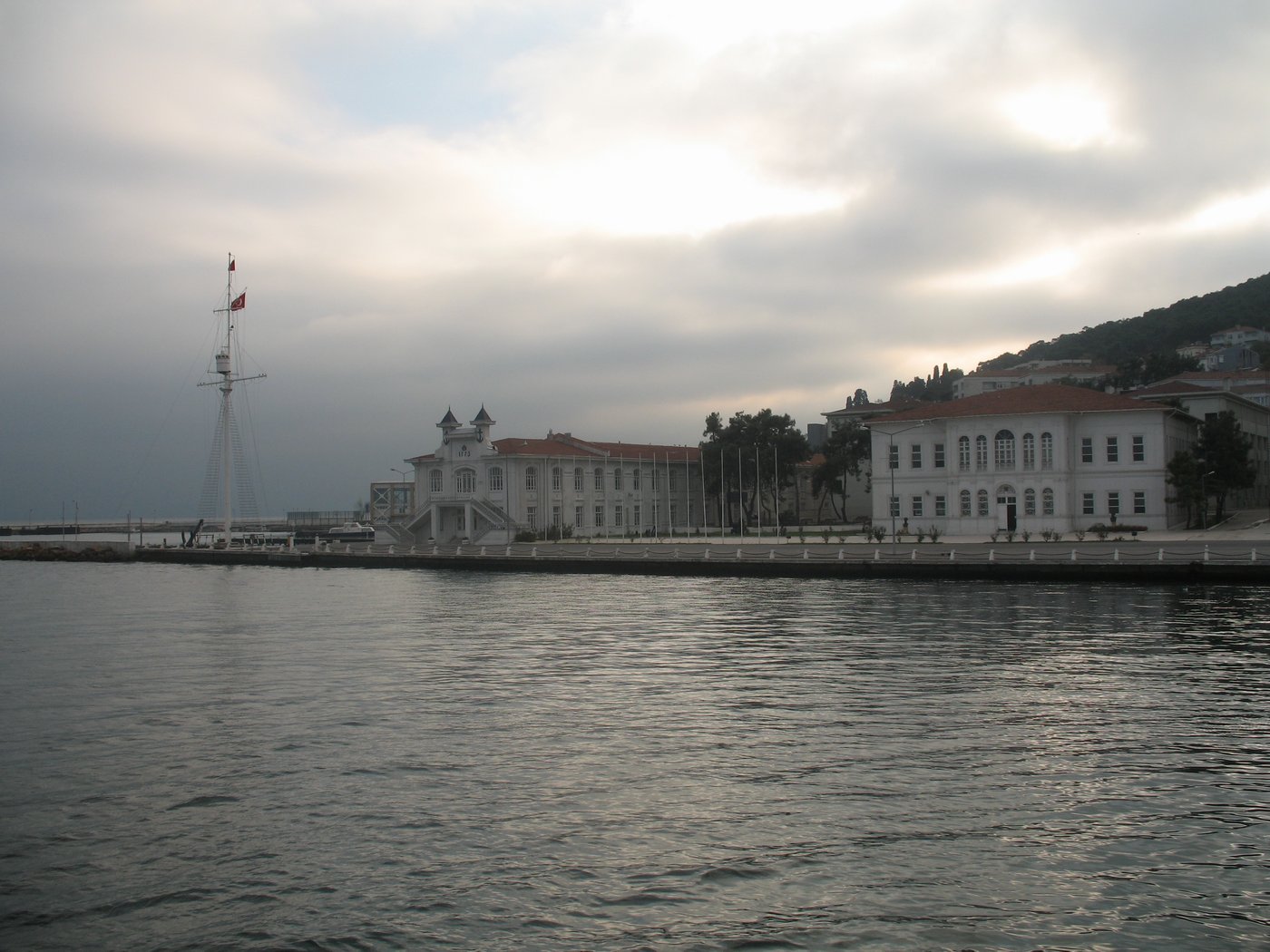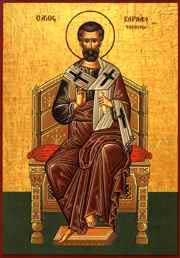|
Gabriel III Of Constantinople
Gabriel III ( el, ), (? – 25 October 1707) was Ecumenical Patriarch of Constantinople from 1702 to 1707. Life Gabriel was born in the town of Smyrna (now İzmir) to parents coming from the island of Andros and in 1688 he became Metropolitan of Chalcedon. He was elected Patriarch of Constantinople on 29 August 1702 and reigned till his death. His reign had no particular troubles and was serene. In 1704, Gabriel formally condemned the edition of the New Testament into Modern Greek translated by Seraphim of Mytilene and edited in London in 1703 by the English Society for the Propagation of the Gospel in Foreign Parts. On 5 March 1705, he issued an order forbidding the Greek students to study in London due to improper behaviours. In 1706, he issued a letter to condemning the Latin doctrines. He also intervened in the affairs of the autonomous Church of Cyprus, deposing Germanos II of Cyprus after complaints of the local population. The Melkite Metropolitan of Aleppo Athanasi ... [...More Info...] [...Related Items...] OR: [Wikipedia] [Google] [Baidu] |
Church Of Constantinople
The Ecumenical Patriarchate of Constantinople ( el, Οἰκουμενικὸν Πατριαρχεῖον Κωνσταντινουπόλεως, translit=Oikoumenikón Patriarkhíon Konstantinoupóleos, ; la, Patriarchatus Oecumenicus Constantinopolitanus; tr, Rum Ortodoks Patrikhanesi, İstanbul Ekümenik Patrikhanesi, "Roman Orthodox Patriarchate, Ecumenical Patriarchate") is one of the fifteen to seventeen autocephalous churches (or "jurisdictions") that together compose the Eastern Orthodox Church. It is headed by the Ecumenical Patriarch of Constantinople, currently Bartholomew, Archbishop of Constantinople. Because of its historical location as the capital of the former Eastern Roman (Byzantine) Empire and its role as the mother church of most modern Orthodox churches, Constantinople holds a special place of honor within Orthodoxy and serves as the seat for the Ecumenical Patriarch, who enjoys the status of ''primus inter pares'' (first among equals) among the world's Ea ... [...More Info...] [...Related Items...] OR: [Wikipedia] [Google] [Baidu] |
Church Of Cyprus
The Church of Cyprus ( el, Ἐκκλησία τῆς Κύπρου, translit=Ekklisia tis Kyprou; tr, Kıbrıs Kilisesi) is one of the autocephalous Greek Orthodox churches that together with other Eastern Orthodox churches form the communion of the Eastern Orthodox Church. It is one of the oldest Eastern Orthodox autocephalous churches; it claims to have always been independent, although it may have been subject to the Church of Antioch before its autocephaly was recognized in 431 at the Council of Ephesus. The bishop of the ancient capital, Salamis (renamed ''Constantia'' by Emperor Constantius II) was constituted metropolitan by Emperor Zeno, with the title ''archbishop''. History Roman era According to the Acts of the Apostles, Paul of Tarsus converted the Roman proconsul Sergius Paulus, (), making him the first Christian ruler, and thus Cyprus became the first country ruled by a Christian leader. A few of the bishops who helped spread Christianity on the island wer ... [...More Info...] [...Related Items...] OR: [Wikipedia] [Google] [Baidu] |
17th-century Eastern Orthodox Bishops
The 17th century lasted from January 1, 1601 ( MDCI), to December 31, 1700 ( MDCC). It falls into the early modern period of Europe and in that continent (whose impact on the world was increasing) was characterized by the Baroque cultural movement, the latter part of the Spanish Golden Age, the Dutch Golden Age, the French ''Grand Siècle'' dominated by Louis XIV, the Scientific Revolution, the world's first public company and megacorporation known as the Dutch East India Company, and according to some historians, the General Crisis. From the mid-17th century, European politics were increasingly dominated by the Kingdom of France of Louis XIV, where royal power was solidified domestically in the civil war of the Fronde. The semi-feudal territorial French nobility was weakened and subjugated to the power of an absolute monarchy through the reinvention of the Palace of Versailles from a hunting lodge to a gilded prison, in which a greatly expanded royal court could be more easily k ... [...More Info...] [...Related Items...] OR: [Wikipedia] [Google] [Baidu] |
1707 Deaths
Seventeen or 17 may refer to: *17 (number), the natural number following 16 and preceding 18 * one of the years 17 BC, AD 17, 1917, 2017 Literature Magazines * ''Seventeen'' (American magazine), an American magazine * ''Seventeen'' (Japanese magazine), a Japanese magazine Novels * ''Seventeen'' (Tarkington novel), a 1916 novel by Booth Tarkington *''Seventeen'' (''Sebuntiin''), a 1961 novel by Kenzaburō Ōe * ''Seventeen'' (Serafin novel), a 2004 novel by Shan Serafin Stage and screen Film * ''Seventeen'' (1916 film), an American silent comedy film *''Number Seventeen'', a 1932 film directed by Alfred Hitchcock * ''Seventeen'' (1940 film), an American comedy film *''Eric Soya's '17''' (Danish: ''Sytten''), a 1965 Danish comedy film * ''Seventeen'' (1985 film), a documentary film * ''17 Again'' (film), a 2009 film whose working title was ''17'' * ''Seventeen'' (2019 film), a Spanish drama film Television * ''Seventeen'' (TV drama), a 1994 UK dramatic short starring Christ ... [...More Info...] [...Related Items...] OR: [Wikipedia] [Google] [Baidu] |
17th-century Births
The 17th century lasted from January 1, 1601 ( MDCI), to December 31, 1700 ( MDCC). It falls into the early modern period of Europe and in that continent (whose impact on the world was increasing) was characterized by the Baroque cultural movement, the latter part of the Spanish Golden Age, the Dutch Golden Age, the French ''Grand Siècle'' dominated by Louis XIV, the Scientific Revolution, the world's first public company and megacorporation known as the Dutch East India Company, and according to some historians, the General Crisis. From the mid-17th century, European politics were increasingly dominated by the Kingdom of France of Louis XIV, where royal power was solidified domestically in the civil war of the Fronde. The semi-feudal territorial French nobility was weakened and subjugated to the power of an absolute monarchy through the reinvention of the Palace of Versailles from a hunting lodge to a gilded prison, in which a greatly expanded royal court could be more easily k ... [...More Info...] [...Related Items...] OR: [Wikipedia] [Google] [Baidu] |
Heybeliada
Heybeliada, or Heybeli Ada, is the second largest of the Prince' Islands in the Sea of Marmara, near Istanbull, Turkey. It is officially a neighbourhood of the Adalar district of Istanbul. Its name, meaning 'with a saddlebag' in Turkish, in supposed reference to the valley between two hills. The island was known as ''Halki'', ''Halkitis'' ( el, Χαλκίτις) and ''Demonesos'' ( Greek: Δημόνησος) in antiquity, the first two toponyms deriving from the Greek word ''halkos'' ( el, χαλκός), meaning copper. The island was famous for its copper and copper ores in antiquity. In winter the island's population is only about 5,500, but in summer, the owners of summer houses return and the population swells to approximately 30,000. Launched in 2008, TCG ''Heybeliada'', used by the Turkish Navy is named after the island. Until 2020, the only vehicles permitted on the island were ambulances, fire tenders, police cars etc; the only official form of transport was by ... [...More Info...] [...Related Items...] OR: [Wikipedia] [Google] [Baidu] |
List Of Archbishops Of Cyprus
This is a list of Archbishops of Cyprus since its foundation with known dates of enthronement. According to tradition, the Church of Cyprus was created by St. Barnabas in 45 AD. The see of Cyprus was declared autocephalous by the Council of Ephesus, on 30 July 431; its autocephaly was abolished in 1260, and was restored in 1571. As the head of the Church of Cyprus, the holder is styled Archbishop of Nova Justiniana and All Cyprus. Archbishops of Cyprus First Autocephalous Period (45–1260) *Gelasios I (325) * St. Epiphanios I (368) *Stavrinos I (403) *Troilos (431) *Reginos (431) *Olympios I (449) *Stavrinos II (457) * Anthemios (470) *Olympios II ''(During the reign of Justinian)'' *Philoxenos ''(During the reign of Justinian)'' *Damianos ''(During the reign of Justinian)'' *Sophronios I ''(During the reign of Justinian)'' *Gregorios ''(During the reign of Justinian)'' *Arkadios ''(During the reign of Justinian)'' *Theophanes I *Plutarch (620) *Arkadios II (630) *Serghios (64 ... [...More Info...] [...Related Items...] OR: [Wikipedia] [Google] [Baidu] |
Proedros
''Proedros'' ( el, πρόεδρος, "president") was a senior Byzantine court and ecclesiastic title in the 10th to mid-12th centuries. The female form of the title is ''proedrissa'' (προέδρισσα). Court dignity The title was created in the 960s by Nikephoros II Phokas and was first awarded to Basil Lekapenos, the eunuch '' parakoimōmenos''. It was placed very high in the court hierarchy, coming immediately below the position of the '' zostē patrikia'' and before the ''magistros'', meaning that it was the most senior non-imperial title open to males. The title apparently continued to be restricted to eunuchs until the mid-11th century, when it was opened up to the wider aristocracy and extensively awarded. The holder of this dignity was also the president of the Senate (), and the term ''proedros'' was often used to denote precedence in other offices, e.g. ''proedros'' of the ''notarioi'' for the '' prōtonotarios''. The title was widely awarded in the 11th century, aft ... [...More Info...] [...Related Items...] OR: [Wikipedia] [Google] [Baidu] |
Athanasius III Dabbas
Patriarch Athanasius III Dabbas (1647–1724), sometimes known also as Athanasius IV, was the last Patriarch of Antioch before the final split of 1724 which divided the Melkite Church between the Melkite Greek Catholic Church and the Greek Orthodox Church of Antioch. He was shortly, from 1705 to 1707, also regent Archbishop of Cyprus, where he is known as Athanasios II. Life Paul Dabbas was born in Damascus in 1647 and studied under the Jesuits. He entered in the Mar Saba monastery where at his priestly ordination he took the name of ''Procopius''. Later he was appointed superior of a monastery in Bethlehem. He later moved to Syria and tried to be appointed bishop of Aleppo, but without success. The situation of the hierarchy of the Melkite Church was actually unstable in such a time. After the death of Patriarch Macarios III Zaim in 1672, the patriarchal throne was disputed between his nephew, Constantine Zaim, who was elected Patriarch at the age of 20 (or less) under the na ... [...More Info...] [...Related Items...] OR: [Wikipedia] [Google] [Baidu] |
Aleppo
)), is an adjective which means "white-colored mixed with black". , motto = , image_map = , mapsize = , map_caption = , image_map1 = , mapsize1 = , map_caption1 = , pushpin_map = Syria#Mediterranean east#Asia#Syria Aleppo , pushpin_label_position = left , pushpin_relief = yes , pushpin_mapsize = , pushpin_map_caption = Location of Aleppo in Syria , coordinates = , subdivision_type = Country , subdivision_name = , subdivision_type1 = Governorate , subdivision_type2 = District , subdivision_type3 = Subdistrict , subdivision_name1 = Aleppo Governorate , subdivision_name2 = Mount Simeon (Jabal Semaan) , subdivision_name3 = Mount Simeon ( ... [...More Info...] [...Related Items...] OR: [Wikipedia] [Google] [Baidu] |
Melkite
The term Melkite (), also written Melchite, refers to various Eastern Christianity, Eastern Christian churches of the Byzantine Rite and their members originating in the Middle East. The term comes from the common Central Semitic Semitic root, root ''m-l-k'', meaning "royal", and by extension "imperial" or loyal to the Byzantine Emperor. The term acquired religious connotations as Christian denominations, denominational designation for those Christians who accepted imperial religious policies, based on Christological resolutions of the Council of Chalcedon (451). Originally, during the Early Middle Ages, Melkites used both Koine Greek, Greek and Melkite Aramaic, Aramaic language in their religious life, and initially employed the Antiochian rite in their liturgy, but later (10th-11th century) accepted Constantinopolitan rite, and incorporated Christian Arabs, Arabic in parts of their liturgical practices. When used in Christian denominations, denominational terminology, ''Melki ... [...More Info...] [...Related Items...] OR: [Wikipedia] [Google] [Baidu] |






